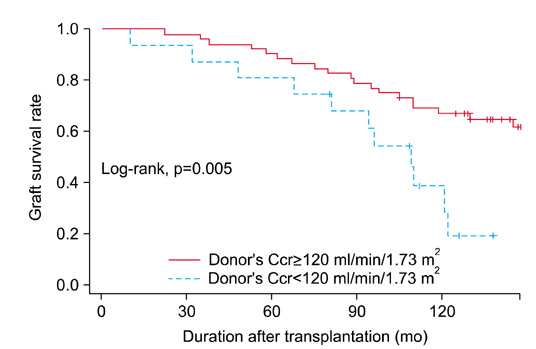Korean J Urol.
2012 Feb;53(2):126-130.
Influence of Donor's Renal Function on the Outcome of Living Kidney Transplantation: 10-Year Follow-up
- Affiliations
-
- 1Department of Urology, Hallym University College of Medicine, Chuncheon, Korea. rheewk@hanmail.net
- 2Department of Surgery, Hallym University College of Medicine, Chuncheon, Korea.
- 3Department of Pathology, Hallym University College of Medicine, Chuncheon, Korea.
Abstract
- PURPOSE
With the improved surgical techniques and immunosuppression available today, conventional prognostic factors have taken on less significance. Accordingly, the native renal function of the donor is thought to be more important. Thus, we analyzed the prognostic significance of the donor's renal function as assessed by 24-hour urine creatinine clearance on kidney graft survival for 10 years after living kidney transplantation.
MATERIALS AND METHODS
From January 1998 to July 2000, 71 living kidney transplantations were performed at a single institution. From among these, 68 recipients were followed for more than 6 months and were included in the present analysis. We analyzed kidney graft survival according to clinical parameters of the donor and the recipient.
RESULTS
Mean follow-up duration of recipients after living kidney transplantation was 115.0+/-39.4 months (range, 10 to 157 months), and 31 recipients (45.6%) experienced kidney graft loss during this time period. Estimated mean kidney graft survival time was 131.8+/-6.2 months, and 5-year and 10-year kidney graft survival rates were estimated as 88.2% and 61.0%, respectively. Donor's mean 24-hour urine creatinine clearance (Ccr) before kidney transplantation was 122.8+/-21.2 ml/min/1.73 m2 (range, 70.1 to 186.6 ml/min/1.73 m2). The 10-year kidney graft survival rates for cases stratified by a donor's Ccr lower and higher than 120 ml/min/1.73 m2 were 39.0% and 67.2%, respectively (p=0.005). In univariate and multivariate analysis, donor's Ccr was retained as an independent prognostic factor of kidney graft survival (p=0.001 and 0.005, respectively).
CONCLUSIONS
Donor's 24-hour urine Ccr before living kidney transplantation was an independent prognostic factor of kidney graft survival. Therefore, it should be considered before living kidney transplantation.
Keyword
MeSH Terms
Figure
Reference
-
1. Evans RW, Manninen DL, Garrison LP Jr, Hart LG, Blagg CR, Gutman RA, et al. The quality of life of patients with end stage renal disease. N Engl J Med. 1985. 312:553–559.2. Kaplan B, Srinivas TR, Meier-Kriesche HU. Factors associated with long-term renal allograft survival. Ther Drug Monit. 2002. 24:36–39.3. Palomar R, Ruiz JC, Zubimendi JA, Cotorruelo JG, de Francisco AL, Rodrigo E, et al. Acute rejection in the elderly recipient: influence of age in the outcome of kidney transplantation. Int Urol Nephrol. 2002. 33:145–148.4. Busson M, N'Doye P, Benoit G, Hannoun L, Adam R, Pavie A, et al. Donor forctors influencing organ transplant prognosis. Transplant Proc. 1995. 27:1662–1664.5. Kwak JY, Kwon OJ, Lee KS, Kang CM, Park HY, Kim JH. Exchange-donor program in renal transplantation; a single-center experience. Transplant Proc. 1999. 31:344–345.6. Benoit G, Bensadoun H, Moukarzel M, Richard C, Castaing D, Izard V, et al. Influence of donor age on graft function in a single procurement center. Transplant Proc. 1990. 22:358.7. Lee CK, Im H, Park SU, Lee SD, Kim JC, Rhew HY. Clinical analysis of 300 renal transplantations. Korean J Urol. 1995. 36:91–98.8. Park CG, Lee JJ, Park HY. Donor factors influencing the graft survival of kidney transplants. Korean J Urol. 1999. 40:1355–1359.9. Foster CE 3rd, Philosophe B, Schweitzer EJ, Colonna JO, Farney AC, Jarrell B, et al. A decade of experience with renal transplantation in African-Americans. Ann Surg. 2002. 236:794–804.10. Cecka JM. The UNOS renal transplant registry. Clin Transpl. 2002. 1–20.11. Port FK, Bragg-Gresham JL, Metzger RA, Dykstra DM, Gillespie BW, Young EW, et al. Donor characteristics associated with reduced graft survival: an approach to expanding the pool of kidney donors. Transplantation. 2002. 74:1281–1286.12. Lee SR, Yoon SN, Lee BM, Oh CK, Kim SJ, Kim H, et al. Changes of glomerular filtration rate of donated and remnant kidneys in a week after living donor kidney transplantation. J Korean Soc Transplant. 2006. 20:55–62.13. Takiff H, Mickey MR, Cicciarelli J, Terasaki PI. Factors important in ten-year kidney graft survival. Transplant Proc. 1987. 19:666–668.14. Taylor CJ, Welsh KI, Gray CM, Bunce M, Bayne AM, Sutton PM, et al. Clinical and socioeconomic benefits of serological HLA-DR matching for renal transplantation over three eras of immunosuppression regimens at a single unit. Clin Transpl. 1993. 233–241.15. Lindholm A, Ohlman S, Albrechtsen D, Tufveson G, Persson H, Persson NH. The impact of acute rejection episodes on long-term graft function and outcome in 1349 primary renal transplants treated by 3 cyclosporine regimens. Transplantation. 1993. 56:307–315.16. Tiong HY, Goldfarb DA, Kattan MW, Alster JM, Thuita L, Yu C, et al. Nomograms for predicting graft function and survival in living donor kidney transplantation based on the UNOS registry. J Urol. 2009. 181:1248–1255.17. Kaplan B. Overcoming barriers to long-term graft survival. Am J Kidney Dis. 2006. 47:4 Suppl 2. S52–S64.
- Full Text Links
- Actions
-
Cited
- CITED
-
- Close
- Share
- Similar articles
-
- The Outcome of Renal Transplantation Using Exchange Donor Program
- Kidney Transplantation after ex vivo Repair of an Aneurysm of the Donor Renal Artery
- Changes of renal function in the remaining kidney after donor nephrectomy
- Recent Advancement of Living Donor Renal Transplantation
- Right kidney living donor transplantation with lesser asymmetric split renal function: two case reports


